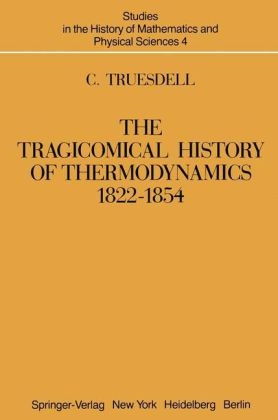
Tragicomical History of Thermodynamics 1822-1854
Springer-Verlag New York Inc.
978-0-387-90403-0 (ISBN)
- Titel ist leider vergriffen;
keine Neuauflage - Artikel merken
1. The Producer’s Apology to the Spectators.- Notation.- Symbols Frequently Used.- 2. The Common Inheritance.- 2A The Thermal Equation of State.- 2B The Theory of Sound in Aeriform Fluids.- 2C The Doctrine of Latent and Specific Heats.- 3. Prologue: Laplace, Biot, and Poisson.- 3A Biot, and Poisson’s First Attempt.- 3B Critique of Biot’s Theory.- 3C Laplace’s Theory of Sound and Heat.- 3D Poisson’s Second Treatment.- 3E Meikle’s Claim.- 3F Critique of Laplace’s and Poisson’s Theories. Correction of Meikle’s Claim.- 4. Act I. Workless Dissipation: Fourier.- 4A Fourier’s Predecessor: Biot.- 4B Fourier’s Program.- 4C Fourier’s Premisses Regarding Specific Heat and Temperature.- 4D Critique of Fourier’s Premisses.- 4E Fourier’s Concept of the Flux of Heat, and his General Differential Equation and Boundary Condition.- 4F Critique of Fourier’s Concepts and Methods.- 4G Fourier’s Theory of the Conduction of Heat in Fluids.- 4H Critique of Fourier’s Theory of the Conduction of Heat in Fluids.- 4I Fourier’s Bequest.- 5. Act II. Dissipationless Work: Carnot.- 5A The General Quality of Carnot’s Treatise.- 5B Standard Concepts and Assumptions Used by Carnot.- 5C The Carnot Cycle.- 5D Carnot’s Claim that Carnot Cycles Attain Maximum Efficiency.- 5E Formal Statement and Critique of Carnot’s Claim of Maximum Efficiency.- 5F Carnot’s Claim that the Efficiency of Carnot Cycles is Universal.- 5G Formal Statement and Elucidation of Carnot’s Claim of Universal Efficiency.- 5H Critique of Carnot’s Argument to Support Universal Efficiency.- 5I Carnot’s General and Special Axioms.- 5J Critique of Carnot’s General and Special Axioms. Scholia I-III. “Carnot’s function”.- 5K Carnot’s Treatment of his Cycle.- 5L Critique of Carnot’s Treatment of his Cycle. Scholion IV.- 5M Critique: Interconvertibility of Heat and Work as Implied by Carnot’s Theory. Proof that Carnot’s Cycles are Indeed the Most Efficient.- 5N Critique: Dimensional Invariance of Carnot’s Theory.- 5O Carnot’s Numerical Evaluation of the Motive Power of Heat.- 5P Critique of Carnot’s Numerical Evaluation of the Motive Power of Heat.- 5Q Carnot’s Theory of Specific Heats.- 5R Critique of Carnot’s Theory of Specific Heats.- 5S Carnot’s Attempts to Determine his Function F.- 5T Critique: Carnot’s Dilemma.- 5U Carnot’s Bequest.- 6. Distracting Interlude: Clapeyron and Duhamel.- 6A Confusion by Awkward Variables: Clapeyron.- 6B Confusion by Linearizing Everything: Duhamel.- 7. Act III. Equivalence, Conservation, Interconvertibility: When and of What?.- 7A Critique: What Did Janus See in 1842?.- 7B Mayer’s Assertion.- 7C Preliminary Critique of Mayer’s Assertion.- 7D Holtzmann’s Assertion.- 7E Preliminary Critique of Holtzmann’s Assertion.- 7F Helmholtz’s Weakest Work.- 7G Joule’s Summary of his Early Experiments.- 7H The Bittersweet Indian Summer of the Caloric Theory: Kelvin’s First Paper.- 7I General Critique: Interconvertibility in 1849.- 8. Act IV. Internal Energy: The First Paper of Clausius. Entropy: The First Paper of Rankine.- 8A Clausius’ Physical Concepts and Assumptions.- 8B Logical Content of Clausius’ First Paper.- 8C Critique: The Achievement of Clausius’ First Paper.- 8D Critique of Clausius’ Reasoning.- 8E Clausius’ Comparisons with Experimental Data.- 8F Critique: Clausius’ Bequest.- 8G Rankine’s First Paper.- 8H Critique of Rankine’s First Paper.- 9. Distracting Interlude: Explosion of Print.- 9A Rankine’s Second Paper.- 9B A Late Re-entrance, Stumbling: Kelvin’s Second Paper.- 9C A Voice Crying in the Wilderness: Reech’s Return to First Principles.- 9D Kelvin’s Analysis of the Joule-Thomson Effect and Subsidiary Details.- Appendix by C.-S. Man: The Joule-Thomson Experiment.- 9E Rankine’s Further Effusions.- 9F Kelvin’s Analysis of the “Anomalous” Behavior of Water.- 9G General Critique: The Disastrous Effects of Experiment upon the Development of Thermodynamics, 1812–1853.- 10. Schismatic Act V. Antiplot in a Dark and Empty Theatre: Reech’s Discovery of a Too General Theory, and his Failure to Reduce It.- 10A Reech Discovers the Pro-entropy.- 10B Reech Generalizes the Internal Energy.- 10C Reech Introduces and Analyses the Thermodynamic Potentials.- 10D Reech’s General Theory of Specific Heats.- 10E Critique: the Fatal Failure of Reech’s Analysis.- Appendix: The Later Work of Reech.- Postscript on maximum efficiency.- 11. Orthodox Act V. Clausius’ Second Paper: Absolute Temperatures, Irreversibility, and Oracling.- 11A Kelvin’s Remarks on Dissipation.- 11B Kelvin’s Absolute Temperatures.- 11C Clausius’Two “Laws” of Thermodynamics.- 11D Clausius’ Equivalence-Value of a Transformation.- 11E Clausius’ Application to the Doctrine of Latent and Specific Heats.- 11F Clausius’Remarks on Irreversible Processes.- 11G Clausius’ Determination of His Universal Function T.- 11H Critique: Empirical and Absolute Temperatures.- 11I Critique: Clausius’”Laws” of Thermodynamics.- 11J Critique: Irreversible Processes.- Epilogue: Götterdämmerung.- Sources.- Index of Persons Mentioned.- Index of Matters Treated.
| Zusatzinfo | Bibliography |
|---|---|
| Verlagsort | New York, NY |
| Sprache | englisch |
| Themenwelt | Mathematik / Informatik ► Mathematik |
| Naturwissenschaften ► Physik / Astronomie ► Thermodynamik | |
| ISBN-10 | 0-387-90403-4 / 0387904034 |
| ISBN-13 | 978-0-387-90403-0 / 9780387904030 |
| Zustand | Neuware |
| Haben Sie eine Frage zum Produkt? |
aus dem Bereich


